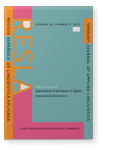Book review
Ostermann, C. (2015). Cognitive Lexicography: A new approach to lexicography making use of cognitive semantics
References (17)
References
Béjoint, H. (2010). The lexicography of English: From origins to present. Oxford: Oxford University Press.
Cowie, A. P. (1999). English dictionaries for foreign learners: A history. Oxford: Oxford University Press.
de Schryver, G. M. (2003). Lexicographers’ dreams in the electronic-dictionary age. International Journal of Lexicography, 16(2), 143–199. 

Fillmore, C. J. (1982). Frame semantics. In The Linguistic Society of Korea (Ed.), Linguistics in the morning calm (pp. 111–137). Seoul: Hanshin Publishing.
Fillmore, C. J. (2003). Double-decker definitions: The role of frames in meaning explanation. Sign Language Studies, 3(3), 263–295. 

Geeraerts, D. (1990). The lexicographic treatment of prototypical polysemy. In S. L. Tsohatzidis (Ed.), Meanings and prototypes: Studies in linguistic categorization (pp. 195–210). London: Routledge.
Johnson-Laird, P. N., & Oatley, K., (1989). The language of emotions: an analysis of a semantic field. Cognition and Emotion, 3(2), 81–123. 

Kövecses, Z. (2000). Metaphor and emotion: Language, culture and body in human feeling. Cambridge: Cambridge University Press.
Lakoff, G. (1993). The contemporary theory of metaphor. In A. Ortony (Ed.), Metaphor and thought (pp. 201–251). Cambridge: Cambridge University Press. 

Lakoff, G., & Johnson, M. (1980). Metaphors we live by. Chicago: University of Chicago Press.
Langacker, R. W. (1987). Foundations of Cognitive Grammar: Theoretical prerequisites. Vol. 11. Stanford, CA: Stanford University Press.
Rosch, E. (1975). Cognitive representations of semantic categories. Journal of Experimental Psychology: General, 104(3), 192–233. 

Rundell, M. (2012). ‘It works in practice but will it work in theory?’: The uneasy relationship between lexicography and matters theoretical. In R. V. Fjeld & J. M. Torjusen (Eds.), Proceedings of the 15th Euralex international congress, EURALEX 2012 (pp. 47–92). Oslo: University of Oslo. Accessed online at [URL].
Tyler, A., & Evans, V. (2003). The semantics of English prepositions: Spatial scenes, embodied meaning and cognition. Cambridge: Cambridge University Press. 

Wierzbicka, A. (1992). Defining emotion concepts. Cognitive Science, 161, 539–581. 

Xu, H. (2015). Treatment of the preposition to in English learnerʼs dictionaries: A cognitive approach. International Journal of Lexicography, 28(2), 207–231. 

